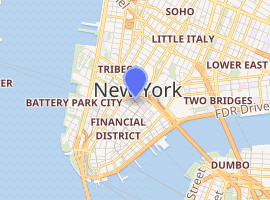Morse Building
The Morse Building, also known as the Nassau–Beekman Building, is a high-rise building located in the Financial District of Manhattan, New York City. The Morse Building was one of the world's first prismatically shaped skyscrapers and, at 140 feet (43 m), one of the tallest buildings in New York City when built. Its sheer walls and flat roof were a departure from designs of previous buildings topped by setbacks, mansard roofs, or towers. It was developed by G. Livingston and Sidney E. Morse, nephews of telegraph inventor Samuel F. B. Morse. The building was designated a landmark by the New York City Landmarks Preservation Commission on September 19, 2006.[1]
| Morse Building | |
|---|---|

| |
| General information | |
| Type | Commercial |
| Location | 140 Nassau Street at Beekman Street, Manhattan, New York City |
| Coordinates | 40.711259°N 74.006165°W |
| Construction started | 1878 |
| Completed | 1880 |
| Height | |
| Roof | 180 ft (55 m) |
| Technical details | |
| Floor count | 14 |
| Design and construction | |
| Architect | Silliman and Farnsworth |
| References | |
New York City Landmark | |
| Designated | September 19, 2006 |
| Reference no. | 2191 |
History
The site of the Morse Building, at the northeast corner of Nassau and Beekman Streets, was the location where Christian newspaper The New-York Observer was published from 1840 to 1859. The architectural firm, Silliman & Farnsworth, filed for the construction of the eight-story building, including a raised basement and an attic. Construction began in June 1878 and was completed in March 1880. Upon its completion, the owners claimed that the Morse Building was “the tallest straight wall building in the world." Interior amenities included 175 offices, two hydraulic Otis elevators, steam heat, gas lighting, and fireplaces.[1]
The base of the Morse Building was damaged in a January 1882 fire that destroyed the old New York World Building. From 1896 to 1900, the Morse Building contained the office and rooftop studio of one of the earliest American motion picture companies, which became the Vitagraph Company of America founded by J. Stuart Blackton and Abert E. Smith.[1]
Description
The Morse Building's design was marked three periods of construction: the original (1878–80), as well as alterations in 1901-02 and c. 1965. Today, the structure’s 6-story midsection, with two articulated facades featuring round- and segmental-arched fenestration, is, in part, the earliest surviving tall “fireproof” New York office building of the period prior to the full development of the skyscraper.[1]
The building was designed in with Victorian Gothic, Neo-Grec, and Rundbogenstil influences. It is an early example of the use of brick and terra cotta for the exterior cladding of office buildings constructed during that time period. The intricate polychrome brickwork was supplied by the Peerless Brick Company of Philadelphia. It features hues of deep red and glazed black, the latter employed ornamentally, largely to emphasize the outlines of the fenestration. The terra cotta was manufactured by the Boston Terra Cotta Co., one of the first East Coast firms.[1]
The building was significantly altered in 1901-02 to an Edwardian Neo-Classical style, designed by of architects Bannister & Schell. The renovations included remodeling the base; reconstructing the upper two stories, capped by a projecting balcony/cornice supported by large scroll brackets; and adding four steel-framed stories clad in cream-colored brick, bringing it to 14 stories. The building's base was altered again around 1965, removing the 10th-story balcony/cornice. The building was converted from commercial to residential use in 1980. One-over-one double-hung wood-framed windows (with transoms in the round arches) were replaced in 1986 with anodized aluminum windows (except for the 8th story, which are mostly wood).[1]
References
- "Morse Building" (PDF). Landmarks Preservation Commission. September 19, 2006. Retrieved March 19, 2017.
External links

- Morse Building - Emporis
